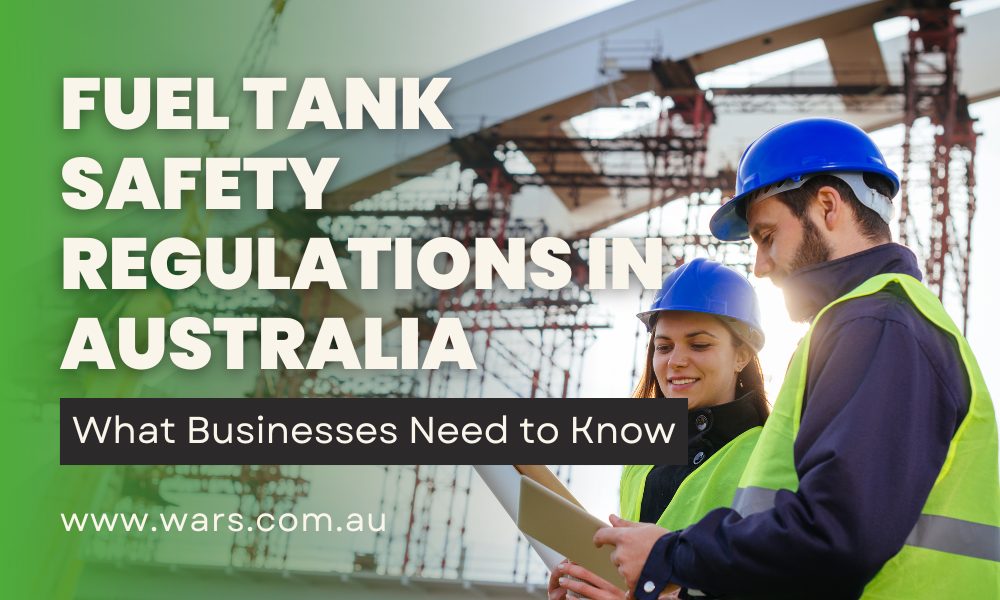
In Australia, ensuring fuel tank safety is crucial for businesses that handle or store fuel safely for generators. With stringent regulations in place, companies must stay informed about the latest tank safety guidelines to protect their operations, employees, and the environment.
At WA Refuelling, we prioritise the highest standards of fuel tank safety. In this article, we explore essential fuel tank safety regulations, highlighting key aspects such as fuel tank security, tank maintenance, and compliance requirements.
Understanding Fuel Tank Safety Regulations
Fuel tank safety is paramount in preventing accidents, environmental damage, and ensuring regulatory compliance. The Australian government has established a framework of safety regulations and standards to manage the risks associated with fuel storage. These regulations aim to safeguard businesses, communities, and natural resources from the hazards posed by fuel tanks.
Key Regulations and Guidelines
To ensure fuel tank safety in Australia, businesses must follow critical regulations and guidelines which include:
1. Australian Standards and Codes
The primary source of fuel tank safety regulations in Australia is the Australian Standards. These standards provide comprehensive guidelines for the design, installation, operation, and maintenance of fuel tanks. Notable standards include:
- AS 1940: The Storage and Handling of Flammable and Combustible Liquids: This standard outlines the requirements for the storage and handling of flammable and combustible liquids, including fuel. It covers aspects such as tank construction, installation, and spill containment.
- AS 1692: Steel Tanks for Flammable and Combustible Liquids: This standard specifies the requirements for steel tanks used for storing flammable and combustible liquids, focusing on design, construction, and testing.
2. Environmental Protection Regulations
Fuel tanks must comply with environmental protection regulations to prevent contamination of soil and water. The Environmental Protection Act and associated regulations mandate that businesses implement measures to contain and manage spills or leaks. This includes regular inspections, maintenance, and the installation of secondary containment systems to capture any accidental releases.
3. Work Health and Safety (WHS) Requirements
The Work Health and Safety Act and Regulations, in each state, require businesses to ensure that their fuel tank installations are safe for workers. This involves conducting risk assessments, providing appropriate training, and implementing safety procedures to handle emergencies. WHS guidelines also cover the safe use of equipment, protective gear, and emergency response plans.
Fuel Tank Security Measures
Fuel tank security is a critical aspect of safety that businesses must address to prevent theft, vandalism, and accidental damage. Implementing robust security measures helps protect valuable assets and ensures compliance with regulations. Key security measures include:
- Access Control: Restrict access to fuel storage areas to authorized personnel only. Use locks, security fences, and access control systems to prevent unauthorized entry.
- Surveillance: Install CCTV cameras to monitor fuel tank areas and deter potential theft or vandalism. Regularly review camera footage and maintain recordings for security purposes.
- Alarm Systems: Implement alarm systems that alert you to unauthorized access or potential leaks. These systems should be integrated with your overall security setup for timely responses to incidents.
Fuel Tank Maintenance and Inspection
Regular maintenance and inspection are vital for ensuring the ongoing safety and functionality of fuel tanks. Adhering to a maintenance schedule helps prevent failures, leaks, and accidents. Key maintenance practices include:
- Routine Inspections
Conduct regular inspections of fuel tanks and associated equipment to identify signs of wear, corrosion, or damage. Inspections should be performed by qualified personnel and include checks for leaks, structural integrity, and compliance with safety standards.
- Preventive Maintenance
Implement a preventive maintenance program that includes tasks such as cleaning, testing, and replacing worn components. Regularly service fuel tanks in western australia and associated systems helps prevent issues before they escalate into serious problems.
- Documentation and Reporting
Maintain detailed records of all inspections, maintenance activities, and repairs. Documenting these activities ensures compliance with regulations and provides a clear history of tank condition and maintenance. This information is crucial for audits and regulatory inspections.
Compliance and Enforcement
Compliance with fuel tank safety regulations is essential for avoiding legal repercussions and ensuring operational safety. Businesses must stay informed about regulatory updates and implement necessary changes to meet evolving standards. Regulatory bodies such as WorkSafe Australia and local environmental agencies oversee compliance and enforce regulations through inspections and penalties.
Best Practices for Fuel Tank Safety
To further enhance fuel tank safety, businesses should adopt best practices beyond regulatory requirements. These practices include:
Training: Provide comprehensive training for employees on fuel tank safety, handling procedures, and emergency response. Regular refresher courses help ensure that staff remain knowledgeable and prepared.
Emergency Planning: Develop and implement an emergency response plan for fuel tank incidents, including spill containment, fire response, and evacuation procedures. Regularly review and practice the plan to ensure readiness.
Safety Culture: Foster a safety culture within the organization by promoting awareness, encouraging reporting of safety concerns, and recognising safe practices. A strong safety culture supports compliance and reduces the risk of accidents.
Take Charge of Fuel Tank Safety with WA Refuelling
Fuel tank safety regulations in Australia are designed to protect businesses, employees, and the environment from the risks associated with fuel storage. By understanding and adhering to these regulations, implementing robust security measures, and maintaining fuel tanks diligently, businesses can ensure compliance and promote a safe operational environment. Staying informed about regulatory updates and best practices will help businesses navigate the complexities of fuel tank safety and maintain high standards of safety and security.
Don’t leave fuel tank safety to chance! Ensure your business meets all regulations and safeguards its operations. For top-notch advice and solutions, visit WA Refuelling or contact us on (08) 9359 1988. Let’s get your safety standards in gear today!
